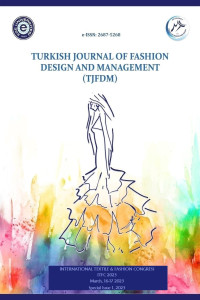Öz
Geçmişten günümüze kadar, at ve binicilik birçok ülkede önemli bir yere sahip olmuştur. Göçebe yaşayan topluluklarda bir araç olarak kullanılan at, aynı zamanda savaşlarda, eğlencelerde ve yarışlarda da kullanılmıştır. Türkler atı evcilleştirmiş ve ata ilk binen toplum olmuşlardır. Günümüze kadar geçen zamanda da birçok oyunda (rahvan, cirit oyunu, atlı okçuluk, atlı güreş) atı kullanmışlardır. Geçmiş dönemlere göre, şu anda bu tür oyunların düzenlenmesi azalmış olsa da dünya üzerinde uluslararası binicilik uygulamaları devam etmiş ve binicilik çeşitleri (üç günlük yarışma, at terbiyesi, engel atlama, atlı dayanıklılık, atlı jimnastik, atlı arabacılık, dizginleme) ön plana çıkmıştır. Buna bağlı olarak binici giysileri önem kazanmış ve tek tip bir binici giysisinin olmamasının yanı sıra giysiler branşlara göre çeşitlilik göstermiştir. Bu araştırmanın temel amacı, binicilik tarihi, branşları, giysileri ve binicilikte kullanılan malzemeler konusunda derleme bir çalışma yapmaktır. Ayrıca çalışma kapsamında hali hazırda kullanılan bir binici giysisinin kumaş ve model yapısı incelenmiştir.
Anahtar Kelimeler
Destekleyen Kurum
ESKİŞEHİR TEKNİK ÜNİVERSİTESİ BAP
Proje Numarası
22LÖT228
Kaynakça
- Aydın, Ö. H. (2018). Horse Racing Industry and Organized Sales. Z Journal, 3, 374-379.
- Dashper, K. & St John, M. (2016). Clothes make rider? Equestrian Competition Dress and Sporting Identity. Annals of Leisure Research, 19(2) 235-250.
- Federation Equestre Internationale The Fei Headquarters Flowchart from https://inside.fei.org/fei/about-fei/structure/fei-headquarters, Date of Access: 05.01.2022
- Ksenophon, (2019). Peri Hippikes. (S. Sandalcı Çev.). Ceren Publishing, Turkey
- Muır, S. & Sly, D. (2009). Horse and rider. Anness Publishing, London.
- Murathan, F., Koç, M., Kartal, M., Murathan, T. (2019). ‘Equestrian in the Ottoman Empire’, Adıyaman University Journal of Social Sciences Institute, 11 (32), 669-807.
- Radtke, S. M. (2010). Dressur. (I. Çakır Çev.). Bilge Kültür Sanat, Turkey.
- Ünver, A. (2006). Equestrian sport from ancient world to Modern Olympics and Olympic development of Turkish Equestrianizm. İmamoğlu, F., https://binicilik.org.tr. 1-128, Science of Physical Education and Teaching of Sport"
Öz
Historically, horse and equestrian have played an important place in many countries. The horse was used as a vehicle in nomadic communities, in wars, entertainments and races. Turkish domesticated the horse and became the first society to ride horses. Until today, they have used the horse in many games (rahvan, javelin game, horse archery, horse wrestling). The organization of such games have decreased exponentially, yet, international equestrian practices have continued in the world and equestrian types (three-day competition, dressage, show jumping, equestrian endurance, equestrian gymnastics, equestrian riding, reining) have become important. Accordingly, equestrian clothes gained importance and besides the lack of a uniform riding clothing, the clothes varied according to the branches. In this context, the aim of this study is to make literature review on the history of riding, its branches, clothes and the materials used. In addition, the examination of the fabric and model formation of an existing equestrian clothing is also included in the aim of the study.
Anahtar Kelimeler
Proje Numarası
22LÖT228
Kaynakça
- Aydın, Ö. H. (2018). Horse Racing Industry and Organized Sales. Z Journal, 3, 374-379.
- Dashper, K. & St John, M. (2016). Clothes make rider? Equestrian Competition Dress and Sporting Identity. Annals of Leisure Research, 19(2) 235-250.
- Federation Equestre Internationale The Fei Headquarters Flowchart from https://inside.fei.org/fei/about-fei/structure/fei-headquarters, Date of Access: 05.01.2022
- Ksenophon, (2019). Peri Hippikes. (S. Sandalcı Çev.). Ceren Publishing, Turkey
- Muır, S. & Sly, D. (2009). Horse and rider. Anness Publishing, London.
- Murathan, F., Koç, M., Kartal, M., Murathan, T. (2019). ‘Equestrian in the Ottoman Empire’, Adıyaman University Journal of Social Sciences Institute, 11 (32), 669-807.
- Radtke, S. M. (2010). Dressur. (I. Çakır Çev.). Bilge Kültür Sanat, Turkey.
- Ünver, A. (2006). Equestrian sport from ancient world to Modern Olympics and Olympic development of Turkish Equestrianizm. İmamoğlu, F., https://binicilik.org.tr. 1-128, Science of Physical Education and Teaching of Sport"
Ayrıntılar
| Birincil Dil | İngilizce |
|---|---|
| Konular | Giyilebilir Malzemeler |
| Bölüm | Derleme Makaleleri |
| Yazarlar | |
| Proje Numarası | 22LÖT228 |
| Yayımlanma Tarihi | 26 Aralık 2023 |
| Yayımlandığı Sayı | Yıl 2023 Cilt: 5 Sayı: Special Issue (I): International Textile and Fashion Congress, ITFC 2023 |
Turkish Journal of Fashion Design and Management (TJFDM) Dergisi, Ege Üniversitesi Moda ve Tasarım Yüksekokulu tarafından yayınlanmaktadır.


